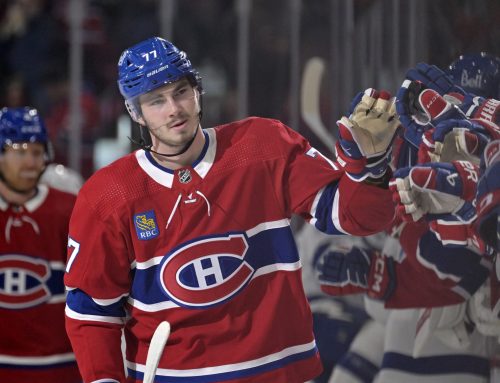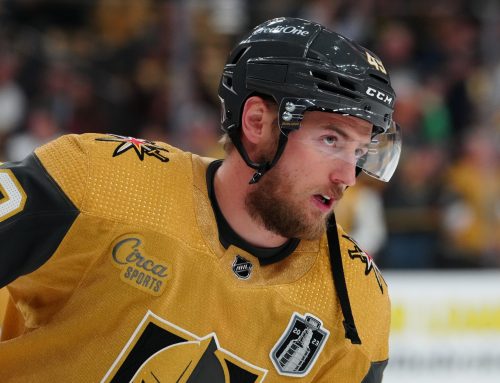Frozen Tool Forensics: Goalies On The Move
Chris Kane
2021-07-30
Wednesday was a wild one. Signings, trades, you name it. It was a particularly incredible day for goalies. We saw quite a few of them move, several teams swapping out their entire tandems. In light of this I wanted to bring back an article from last summer where I dug into goalies on the move and how they performed on their new teams. I think the interesting question is, what happens to goalies after they move teams? Do they perform better? Worse?
A deep analysis here would require a lot of information. A dive into each goalies' personal histories, their individual numbers, their old team's numbers and playing style, and their new teams' numbers, roster configurations etc. In this case we won't be getting into that level of detail for each move. Check out Dobber's impact articles for more on that (here and here). In this article we will be focusing on a few data points for each goalie to see if there are any trends.
So without further ado, let's jump into process
I built off of the data set I created last year which focused on guys who could have been reasonably fantasy relevant the season before and then switched teams. Basically goalies who switched teams after playing around 30 games with that first team. I ended up having to do some digging through old trade and free agent trackers, and then Player Profile-ing the heck out of the Frozen Tools section to track everything down.
The original data set included three seasons worth of goalie data – goalies that moved in the summers of 2017, 2018, and 2019. I have added 2020 to that list. The main focus of the data is games played and save percentage as rough stand-ins for value in most league formats.
Quick side note: I extended all 2020 and 2021 goalie numbers to what their 82-game pace would have been so we can have a more even comparison to previous seasons. That means 2020 and 2021 goalie games played numbers will look a little different in our data and discussions than in their Player Profiles.
The set included 35 instances of goalies switching teams over the last four seasons. The average age of the sample is still 31, goalies averaged 42 games with their initial team, and 36 after their move. They averaged a .911 save percentage with the initial team and a .909 with the second. In the broadest most general context, it seems like moving teams means fewer games played and a slightly worse performance.
In order to break down the data I created a few tables looking at several factors. We will be focusing on goalie age, games played on the original team, and save percentage on the original team. The idea is to see if by knowing those three factors we can make a guess about what will happen to a goalie on the move this season.
Age
| Age | N SIze | # of Goalies Lost Games | % of Sample | Av # of Lost Games | Added Games | % of Sample | Av # of Added Games | # Goalies Decreased SV% | % of Sample | Av Decrease in SV% | # Goalies Increased SV% | % of Sample | Av Increase SV% | |
| <30 | 15 | 8 | 53% | 6 | 7 | 47% | 10 | 10 | 67% | 0.011 | 5 | 33% | 0.01 | |
| 31-34 | 13 | 8 | 62% | 11 | 4 | 31% | 13 | 6 | 46% | 0.012 | 7 | 54% | 0.013 | |
| 35+ | 7 | 6 | 86% | 29 | 0 | 0% | 0 | 3 | 43% | 0.017 | 2 | 29% | 0.003 |
The table is a little unwieldy, so let's break it down. The three rows are different age brackets, younger than 30, 31-34, and over 35. Each of the age brackets has results broken out by games played (white columns) and save percentage (grey columns). These columns show how many goalies lost or gained games/SV%, what percent of the total group that represented, and the scale of that change (amount of added/lost games, or increase/decrease in SV%).
Starting on the top left we can see that 15 of the goalies moved in the last four seasons have been under 30. A total of 53 percent (or eight) of those goalies lost games after their move and on average lost six games. Seven goalies (47 percent) gained games and gained ten games on average.
I would summarize the data by saying that all age groups are more likely to lose games on average, but the age group most likely to lose games is the 35+ group (86% of them lost games played, and no one gained games). Additionally, when they lose games, they lose big. The average was 29 lost games versus the under 30s lost only six. The splits for the other two groups is a bit more even.
Moving on to save percentage we can see that our younger goalies are more likely to see a dip in their save percentages in the season after their move (67% of under 30s vs 43% of over 35s), but that older goalies do see a slightly bigger change when it happens (.011 save percentage change compared to .017).
Games Played
| Games Played | N SIze | # of Goalies Lost Games | % of Sample | Av # of Lost Games | Added Games | % of Sample | Av # of Added Games | # Goalies Decreased SV% | % of Sample | Av Decrease in SV% | # Goalies Increased SV% | % of Sample | Av Increase SV% | |
| 40+ | 14 | 12 | 86% | 14 | 1 | 7% | 13 | 8 | 57% | 0.012 | 6 | 43% | 0.008 | |
| <40 | 20 | 9 | 45% | 11 | 10 | 50% | 11 | 11 | 55% | 0.012 | 8 | 40% | 0.013 |
The games played numbers are based on how many games a goalie played prior to their move. Our two categories here are more than 40 games, and less than 40. According to our data, 86 percent of goalies who played more than 40 games prior to their move played fewer games the next season. On average they lost 14 games. Goalies who played less than 40 games are a much more mixed bag breaking pretty evenly as to whether or not they are likely to gain or lose games.
In terms of save percentage there don't seem to be a lot of trends here. Both categories break pretty evenly.
Save Percentage
| SV% | N SIze | # of Goalies Lost Games | % of Sample | Av # of Lost Games | Added Games | % of Sample | Av # of Added Games | # Goalies Decreased SV% | % of Sample | Av Decrease in SV% | # Goalies Increased SV% | % of Sample | Av Increase SV% | |
| <.900 | 7 | 7 | 100% | 8 | 0 | 0% | 0 | 2 | 29% | 0.009 | 5 | 71% | 0.01 | |
| .900-.910 | 9 | 5 | 56% | 15 | 3 | 33% | 8 | 2 | 22% | 0.01 | 6 | 67% | 0.128 | |
| .910-.92 | 12 | 8 | 67% | 18 | 3 | 25% | 13 | 9 | 75% | 0.01 | 1 | 8% | 0.01 | |
| >.920 | 7 | 2 | 29% | 18 | 5 | 71% | 12 | 6 | 86% | 0.017 | 1 | 14% | 0.008 |
Our final table reviews save percentage. All of the goalies who had sub .900 save percentages lost games the next season. They were fairly likely to improve their save percentages, but not necessarily by an exciting amount comparatively. The .910-.920 group was also surprisingly likely to lose games played, and also fairly likely to lose percentage points. On the flip side our greater than .920 save percentage group was likely to increase games played, but even more likely to drop save percentage and fall off pretty substantially. This isn't really surprising since a .920 save percentage or higher is pretty hard to sustain regardless.
What we do with all of this info will depend a little bit on your league settings and your expectations for goalies, but here are some statements we can make.
- Age is very directly correlated to performance. Younger goalies are more likely to perform better in their new environment both in terms of games played and save percentage.
- Goalies that have moved and have save percentages over .910 are very likely to drop in save percentage and given the amount of average drop are more likely to find themselves in the .900 to .910 range.
- Goalies with save percentages less than .910 are reasonably likely to improve their saver percentages.
- Goalies that are 35 or older, have started more than 40 games, or have a save percentage less than .900 prior to their move are very likely to lose starts in their new location.
- Goalies with save percentages greater than .920 are the only goalie group likely to gain games played the following season.
Time for a quick application.
| Age When Moved | Year moved | SV% Before Move | GP Before Move | |
| Darcy Kuemper | 27 | 2021 | 0.907 | 40 |
| Linus Ullmark | 27 | 2021 | 0.917 | 29 |
| Jonathan Bernier | 32 | 2021 | 0.914 | 35 |
| Philipp Grubauer | 29 | 2021 | 0.922 | 59 |
| Frederik Andersen | 31 | 2021 | 0.895 | 35 |
| Jaroslav Halak | 36 | 2021 | 0.905 | 28 |
Darcy Kuemper appears likely to maintain or slightly increase games played (age indicates increase, save percentage and games played numbers are fairly neutral), and increase save percentage (prior save percentage and age indicate potential increase, games played numbers are neutral).
Jaroslav Halak's save percentage might be okay next season, his age and games played numbers are pretty neutral, while his prior year's save percentage indicate a potential for growth. His games played projections are not good though. His age is a big warning sign for losing starts, and his save percentage and prior games played numbers indicate neutral at best.
Philipp Grubauer is a pretty mixed bag. He has a big prorated games played number, and we would typically expect that to decrease, but his .920 save percentage and his age would imply an increase in starts. Future save percentage is similarly mixed, his age implies a better season ahead, his games played numbers are neutral to positive, but his prior save percentage would imply a drop for next season.
Just as a reminder, these data are not the end all and be all. When we are looking at individual cases and making drafting decisions it is definitely important to consider roster and coaching styles, particularly situations where a goalie is moving to or from a tandem situation.
That's all for now. Stay safe out there.
Help make hockey accessible for everyone. Start by supporting:





 CAR
CAR NYI
NYI BOS
BOS TOR
TOR MTL
MTL T.B
T.B COL
COL VAN
VAN VGK
VGK EDM
EDM S.J
S.J
